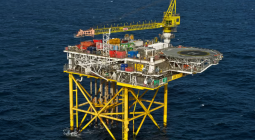The biggest oil spill in US history: What we've learned since Deepwater Horizon

Over a decade on from the Deepwater Horizon oil spill, could we do a better job at cleaning it up today? (Credit: Getty Images)
Fourteen years after the BP Deepwater Horizon disaster, would we fare any better at cleaning up another huge oil spill? Jocelyn Timperley examines the latest science of ocean clean-ups.
On April 20, 2010, a blowout caused a huge explosion on the offshore drilling rig operated by BP in the Gulf of Mexico. Eleven people were killed. Two days later, the rig collapsed. Oil began seeping into the sea, and it continued to flow for almost three months.
The Deepwater Horizon disaster is among the most lamented environmental catastrophes of the past century. It's hard to comprehend how incredibly huge the spill was. It was the world's largest ever marine oil spill, releasing an estimated 4.9 million barrels of crude oil (779 million litres, or over 300 Olympic swimming pools-worth). Up to a million seabirds were killed outright, and the human health and socioeconomic effects are still being felt today.
BP, rig operator Transocean, and several government agencies immediately tried to limit the damage, with BP's chief executive saying the company was "determined to do everything in our power" to contain the spill. Booms were deployed to try to contain the oil, skimmer ships nibbled at the edges of the widening slick and fires were set to try to burn it off the sea surface. Various devices were deployed deep below the surface to try to contain or capture the oil. BP also began to spray the oil with enormous amounts of dispersants both on the sea surface and 1.5km (0.9 miles) underwater, where oil was gushing from the wellhead.
However, it is thought that these measures recovered or dispersed only around a third of the spilled oil. The BP spill sparked a huge amount of research into oil spills and their impacts. But 14 years on, what hope is there for better measures should another oil spill occur?
Jeffrey Short, an expert in oil spills and now-retired scientist from the US National Oceanic and Atmospheric Administration (Noaa), was working for Oceana, a marine conservation organisation when the BP spill occurred. When a colleague told him about the spill at lunchtime, he felt sick.
"I knew immediately that this would be ecologically and economically disastrous, that it would wreck tens of thousands of people's lives, and that it would dominate my professional life for the next several years," he says. "All of which proved true."
Oil spills are the third largest source of oil in the sea, after land-based runoff (largely from cities and vehicles) and natural oil seeps. The problem with spills, of course, is the sheer volume of oil that enters the sea all at once. This means that oil spills – especially big ones – are "much, much more dangerous per unit oil released", says Short.
While no spill has since surpassed Deepwater Horizon's in sheer volume, Noaa responds to more than 150 oil spills every year. Just last month, oil began spewing from a submerged oil tanker and at least two other sunken vessels in Manila Bay, in the Philippines, after they were hit by monsoon rains and Typhoon Gaemi. Another oil tanker hit by projectiles from Yemen's Houthi movement remains in a precarious position in the Red Sea. However, the number of oil spills from tankers is today far lower than in the 1970s, due to improved standards.
When oil spills occur, the first step is to control the source, "whether that be a ship, pipeline, or leaking well", says Doug Helton, regional supervisor of the emergency response division at Noaa's Office of Response and Restoration. "The second priority is recovering oil at sea."
The major priority is to avoid the oil reaching the shoreline, where it can do the most damage. Shoreline cleanups can last days to years, depending on the type of oil and severity of contamination, says Helton.
Spilt oil tends to spread quickly into a thin layer on the sea surface. Within days, centimetres-thick layers become a film of a millimetre or less, spread in drifting patches over a wide area. Efforts to scoop up the oil from the sea surface therefore offer diminishing returns as time goes on. "Floating oil spreads very quickly and there is a limited window of time – days – when at-sea tools are effective," says Helton.
Hundreds of skimmers were deployed to clean up the BP Deep Horizon spill. Skimmers are boats that scoop up spilled oil from the water's surface, usually after the slick is first surrounded with floating booms to keep it from spreading. They do this in various ways – some, for example, suck up the oil like a vacuum cleaner, while others use oil-attracting "conveyor belts" or gravity to carry the spilled oil into a reservoir.
But hopes at the time that the skimmers could pick up oil "like a lawnmower cutting grass" proved to be overblown. They only recovered an estimated 3% of the oil. "At sea, the oil may spread more rapidly than the skimming vessels trying to capture oil," says Helton. "Going faster is not an easy option because the bow wave from the ship will push the oil away."
The satellite photos of the BP disaster "speak volumes", says Short. "You'll see a half a dozen surface skimming boats that, from the sea surface next to the boat, look quite large and quite effective. But from a satellite, you realise that you are [...] just having a nearly negligible effect on the size of the spill."
In fact, a 2020 review of 30 large offshore oil spills found only 2-6% of oil was recovered using mechanical methods like skimmers. Short says that mechanical recovery has improved in recent decades, with better booms to corral the oil and better systems to remove it from the sea surface. But even with improvements, mechanical methods can't have much impact on a large spill, he says.
In recent years a plethora of studies and reports have emerged looking at different ways to soak up oil spills, from laser-treated cork and textiles based on leaves to graphene, magnets and even hair and fur. These mostly rely on the oil-attracting and water-hating properties of the material, with various forms of oil-attracting sponges a particularly common solution. But the difficulty of handling oil-soaked materials means these techniques are typically only useful for small spills.
When Guihua Yu, a professor of materials science at the University of Texas at Austin, and his team began considering whether a new material his lab was working on could be used to help clean up oil spills, he says he was surprised about the lack of focus on how these innovative materials could be used in practice.
One central problem, he says, is that most can only be used in a non-continuous way, requiring processing to remove the oil before the same material can be used again.
Yu and his team landed on a solution which he thinks could help. In a 2023 paper, his lab developed a prototype with a collection speed 10 times faster than current clean up rates.
The lab produced their own super oleophilic gel capable of 99% separation of oil from water, which they used to cover a mesh filter. But they also designed a continuous roller system, which Yu says would be attached to the front of a ship. This conveyer belt picks up oil from the water surface, then rolls it round to beside an induction heater, which heats the oil, detaching it and allowing it to drip down to a collector in the middle. The roller is freed up to be directly reused as it rolls down to the water again.
"The most important [innovation in our work] is probably higher throughput," says Yu. "I personally felt it's very unique and very different from what is conventional."
The invention has so far only been tested on a small motor oil spill in a lake in China using a metre-scale prototype, but Yu says he has had conversations with industry potentially interested in scaling it up. The overall costs, he believes, would be reasonable. However, he admits his current design does not address the bow-wave issue of oil being pushed away from the ship, noting that how to balance collection and bow wave is "worthy of further investigation".
But Short says that, for large spills which require more than a day to clean up, movement of oil during the night (when operations can usually not be carried out) will always limit the efficacy of collecting oil on the sea surface.
"The following day, the oil must first be located before response equipment can be effectively deployed," he says. "For large spills, especially when response equipment is limited, these challenges may limit the amount of recoverable oil to less than 10% of the initial spill volume."
Still, improvements have been made in tracking the oil too. Noaa now uses drones and satellites to help find and track oil spills, and tools for mapping and coordination have advanced. Undersea manned and autonomous tools that can tap into sunken vessels to extract oil have also been developed since the Deepwater Horizon spill, says Helton.
Burning is another, more controversial, way to remove floating oil at sea. An estimated 5% of the BP oil spill was burnt off the surface.
Burning requires concentrating the oil on the sea surface to at least 2-3mm – relatively thick for an oil spill. It also requires quick action, and lucky weather conditions. In the Exxon Valdez oil spill in Prince William Sound, Alaska in 1989, a storm dispersed the oil over a wide area into a film too thin to catch alight.
Improved boom designs to better corral oil have improved the effectiveness of burning over the years, says Short. But successful burning also has its own problems for the environment and human health in the form of air pollution.
The impacts of air pollution on the workers attempting to clean up the BP oil spill are still being investigated today. A major 2022 study found that workers involved in cleaning up the spill were 60% more likely to be diagnosed with asthma or experience asthma symptoms one to three years after the spill, compared with those who did not work on the cleanup.
Burning is not the only culprit for air pollution. The evaporation of the oil itself is also highly toxic, as is another controversial way to try to dissipate the impacts of oil spills: dispersants.
During the Deepwater Horizon disaster, BP sprayed roughly 1.84 million gallons (8.37 million litres) of the dispersant Corexit on the surface and deep into the water column – the largest volume of dispersant ever used for an oil spill.
Dispersants work by breaking down the oil into smaller droplets that can mix with the water below, which both helps it to degrade and removes it from the surface, where it tends to do most damage (especially to diving seabirds, surfacing marine mammals, turtles and young fish). But it needs to be added quickly after oil spills.
Little was known about exactly how this quantity of dispersant would affect the environment in the BP spill, but the hope was that it would stop the oil from reaching shoreline habitats. But the sheer volume used has been widely criticised as largely ineffective as well as harmful to the environment and humans. It's thought just 8% of the oil was dispersed using Corexit.
In Short's view, prior knowledge about oil spills meant that in the Deepwater Horizon spill "you can be quite certain in advance" that the continued application of dispersants on parts of the oil slick which had already emulsified was "a waste of time" beyond the first few days. "But it shows the public that you're doing something."
Environmentalists and scientists have a term for these kinds of reactions to oil spills – "response theatre". It describes when companies responsible for a spill focus more on being seen to do something about the spill than necessarily doing the best thing.
Some researchers, however, say the dispersants were relatively effective and may have helped avoid further air pollution by getting rid of the oil. A 2019 report from the US National Academies found that dispersants can help cope with oil spills in some circumstances, but that limitations in the research make it hard to make conclusions about whether it improves the human health aspect compared to not using dispersants.
A study published in 2024 became the first to use an advanced microbiology technique to look at these interactions. Rather than look at the DNA of microbes, as previous studies have done, the scientists examined the protein expression of microbes in waters off the coast of Florida – a technique usually only used in medical or clinical science.
Using these techniques can show far more detail than looking at DNA alone, says Sabine Matallana-Surget, an associate professor of environmental and molecular microbiology at the University of Stirling, Scotland, who led the study. If she did a similar study on humans, for example, she would be able to tell when they had lunch by tracking the enzymes involved in food digestion.
Her team found that Corexit induces a high expression of proteins involved in oxidative stress in oil-degrading bacteria. "I have never seen so many proteins involving DNA damage [and] repair, [as] when you introduce the Corexit to your microbial community," says Matallana-Surget. More sunlight also increased the toxicity of Corexit and oil in their experiment, creating a "double pill effect", she adds.
The team plan to conduct similar experiments in other places with natural seepages of oil, with different microbes, temperature and sunlight levels. If there is another oil spill in one of these places, Matallana-Surget says, these findings could inform the optimum level of Corexit to use in that particular location for maximum oil recovery. "I'm hoping that in the near future, if there was an accident somewhere else, we would be able to say, 'Well, listen, no, you shouldn't apply Corexit in that region, or not as much, or maybe this concentration.'"
Dispersants aren't the only intervention after oil spills that have caused concern. "We have found after lengthy research that aggressive cleanup of some environments can cause more harm than the oil," says Helton. "Marshes and sheltered intertidal habitats, for example, are often treated very carefully."
The high-pressure, hot-water washing used to clean the ecologically sensitive shorelines of Prince William Sound in Alaska after the 1989 Exxon Valdez spill, for example, sterilised the beaches, inadvertently killing bacteria as well as larger animals. Research has shown that areas not cleaned by the hot water recovered faster than the treated sites.
If a spill like Deepwater Horizon happened today, says Matallana-Surget, the reaction would be completely different. "There have been huge conversations around what happened with applying tonnes of [a] chemical [where] we have no idea what's going in the environment. I think nobody in any part of the world would do that."
Ultimately, since spills are so hard to clean up, avoiding them happening in the first place remains the most important thing. "Prevention is going to be the most fruitful line of approach," says Short. "Continuing to implement safety measures and especially being vigilant." The problem is that standards are expensive to maintain, he says. If years go by without a spill, they "tend to start slipping".
Major changes have been made to US regulations governing offshore oil and gas operations, as well as advances in preventing blowouts in the first place. New performance measures and enforcement mechanisms have been introduced to improve pipeline safety. However, there are also new potential risks for oil spills: deeper drilling, ageing infrastructure, transport of new types of oil and through different routes such as the Arctic, and climate impacts like sea-level rise and more intense and frequent storms.
A report released by BP in September 2010 concluded that decisions made by "multiple companies and work teams", including BP and others, had contributed to the spill. The unprecedented costs – over $65bn (£49bn) – to BP of the Deepwater Horizon has acted as an incentive to companies maintain the vigilance to avoid future disasters, says Short. "I think that's really got a lot of attention in the industry, that this is not a trivial operating expense that you can just write off as business as usual."
BP also quickly announced $500m (£380m) for a 10 year research programme, which has been credited with galvanising advancement in oil spill science.
But while risks can be reduced, so long as oil is being produced, "you're not going to get rid of [spills]", adds Short. Oil supply is set to reach a record high this year, with the US last year producing more oil than any country ever has before. Until oil dependence begins to fall, sadly the risks of another oil spill will stay with us.
Both BP and ExxonMobil declined to comment for this article.





